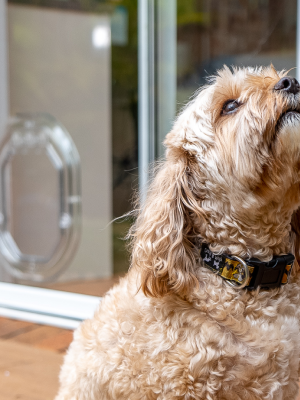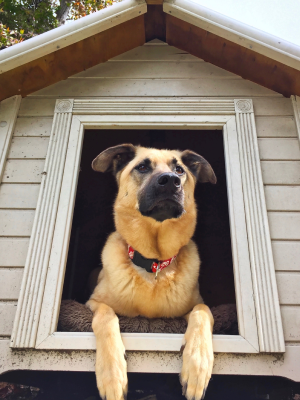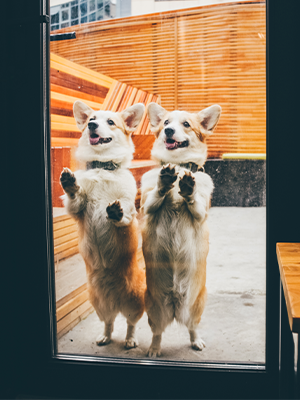
Pet doors are a great way for your dog or cat to get in and out of the home. There are different types of pet doors and each type operates differently. The traditional basic plastic flap door allows the pet to go in and out manually, while electronic and microchip doors operate automatically. In this article we will guide you through what pet doors are, the different types of pet doors and how each works, and how to choose the right pet door.
Our Blog
Our Blog
12/8/25
How Do Pet Doors Work?
Pet doors are a great way for your dog or cat to get in and out of the home. There are different types of pet doors and each type operates differently. The traditional basic plastic flap door allows the pet to go in and out manually, while electronic and microchip doors operate automatically. In this article we will guide you through what pet doors are, the different types of pet doors and how each works, and how to choose the right pet door.
What Are Pet Doors?
Pet doors are doors specifically designed and built for dogs and cats to go in and out of the home. It is a small opening usually located in a door or a wall with a flap that opens manually or automatically depending on the type of pet door. Pet doors provide a convenient way for dogs or cats to be able to leave and enter the premises without needing human assistance or supervision. Also known as cat or dog flaps, doggy or kitty doors, they were originally just a hole in the door but now they have a spring-loaded panel or flexible flap that opens and closes to allow the pet to enter or exit the home.
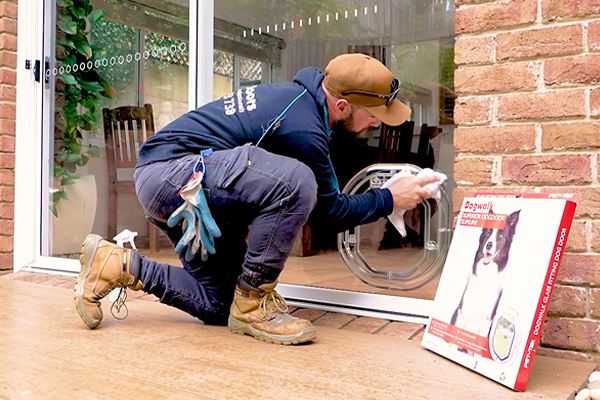
Types of Pet Doors and How They Work
The simplest type of pet door is a small hole in the wall with bottom-weighted flaps hanging from the top of the opening to let the pet go in and out of the home. These days there are all types of pet doors from manual to automatic and microchip. There are pet doors for walls, glass and screens, each operating with different mechanisms and different features. We look at each type of pet door and explain how they work.
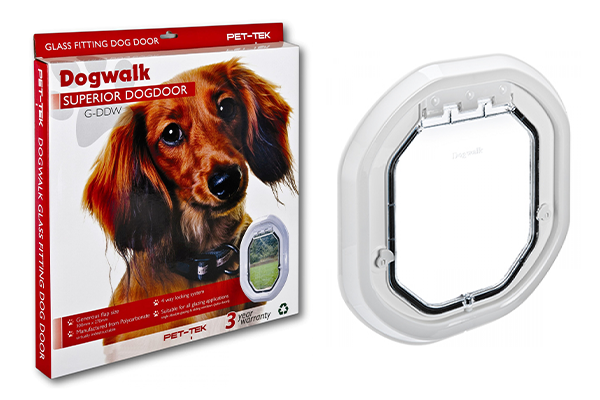
- Pet doors with two-way locking: A pet door with two-way locking has two-ways to control your pet’s access with either the locked or unlocked setting. When the door is unlocked the pet can go in and out of the home freely. When it is locked, there is no access from inside or outside. two-way locking pet doors can be good if you simply want to restrict your dog or cat from going outside at times. In locked mode, they can also prevent other animals from entering the home. A two-way locking pet door is a low cost way to have the convenience of a pet door.
- Pet doors with four-way locking: A pet door with four-way locking gives more control over the locking mechanisms than a two-way locking system. With a four-way locking pet door, you can control four settings by locking the door completely, allowing entry and exit, allowing entry only or exit only. This offers more flexibility allowing pet owners to decide when the pet can go outside or come inside and is good for restricting access.
- Automatic pet doors with magnets: Some automatic pet doors work via magnets that are attached to the dog or cat’s collar. The pet door has a mechanism that detects the magnetic key and opens the door when the pet approaches. Some automatic pet doors are also always locked until the pet with the magnetic key comes close for an extra level of security. With an automatic pet door with magnets you can also control which pets can come and go from the house.
- Microchip pet doors: Using a pet’s microchip to open or close the flap, a microchip pet door allows your dog or cat easy access in and out of the home. The microchip works on the same principle as a key. The microchip is embedded into the cat or dog, and the door is programmed to recognise the individual chip and open the pet door. If you have a cat that doesn’t have a microchip, you can use a lightweight collar with a programmed chip just as easily.
- Pet doors for walls: For homes where a door installation is not ideal, there are pet doors for walls. Just like door installed pet doors, these devices allow the dog or cat to enter or exit the house at their leisure. These are a permanent opening on the wall with a simple flap mechanism that swings both ways allowing outdoor access for dogs or cats. These pet doors are good for external walls like brick and weatherboard.
- Pet doors for glass: There are pet doors for glass made for both dogs and cats. A pet door for glass is basically a pet door that is designed specifically for glass applications and to fit flush with the glass panel. They can be fitted into all types of glass including standard, laminated, tempered and double-glazed. These pet doors are suitable for all shapes and sizes from the largest of dogs to the smallest cat.
- Pet doors for sliding doors: A pet door for a sliding door is usually a glass panel with a built-in pet door sitting in the track of the sliding door instead of against the door frame. During installation, a panel is inserted into the sliding door track. This new panel has glass on top and a pet door flap at the bottom. These are the easiest type of pet doors to install as they require no cutting or drilling into the door itself.
- Pet doors for screens: A pet door for a screen is a pet door for a dog or cat that is installed in a screen door, usually a flywire (mesh) or security screen. These doors for dogs or cats give your pet the freedom to go outside and come back in as they please. Pet doors for screens are available in all sizes and will suit small, medium and large dogs. These doors are designed to fit flush with the door frame.
How To Choose The Right Pet Door
When choosing the right pet door it is important to take into account the type of pet you have, its size, the weather, and your type of home. Consider these factors to help you choose the right pet door for your needs.
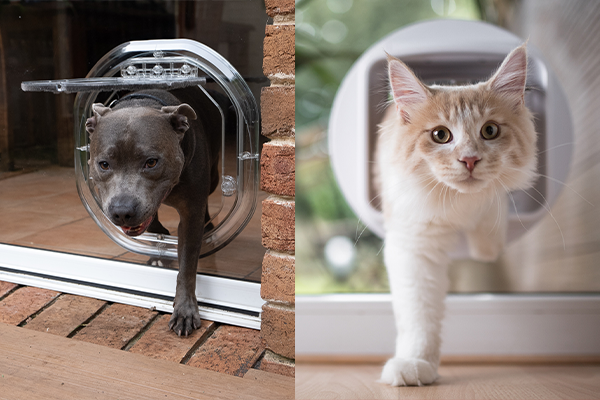
- Type of pet: The type of pet you have will influence the type of pet door you should choose. For those with cats, cat doors tend to be smaller and have a rigid clear flap. Dog doors on the other hand tend to be larger with a more flexible flap. However, if you have a dog and cat, you could allow both pets to access a dog door.
- Size of pet: it is important to choose the right pet door for the size of your pet. A door that is too small could cause injury or discomfort and even result in the animal not wanting to use it. A door that is too large will impede energy efficiency in the home. To work out your pet’s size to select the correct door, measure the height at the shoulder and width at the hips or shoulders whichever is wider. A dog will need about five centimetres clearance around the pet door and a cat will need significantly less, around 2-3 cm.
- Weather: The weather and climate where you live will affect the type of door you need. If you live in an area with extreme weather conditions you will need a pet door made of durable materials and with strong seals to prevent leaks and potential damage. A location with a mild climate is ideal for a pet door with basic flaps and construction.
- Home features: If the home does not have a viable door to install a pet door, you will need to consider alternatives like a pet door in a wall. Similarly, if there is only a sliding security door, a pet door specifically designed for this application will need to be installed.
- Budget: Pet doors do range in price from basic models at the lower end of the price scale to modern automatic doors that cost more. Consider your budget when choosing a pet door but remember that the less expensive choice may not necessarily be the best choice in terms of durability and security.
How Secure Are Pet Doors?
When looking at how pet doors work, it is common to ask if they pose a security risk. Most pet doors do not pose any issues with security as they are usually too small for a person to climb through. If you are concerned about installing a pet door because of security issues, follow these tips to ensure your pet door is as safe and secure as possible.
- Buy the right sized pet door: Make sure your pet door is big enough for your pet but not overly large to let a person climb through. Most dogs and cats will need a small to medium sized pet door for comfortable access.
- Install in a wall: Sometimes installing a pet door in a wall is a better option for security as a burglar cannot reach in and open the door latch if installed on a wall.
- Install a pet door with advanced security features: Pet doors with advanced security features like microchip pet doors are excellent for security. They can be integrated with the home’s security system and connect to a smartphone for access and management. The materials the pet door is made from can impact security so choose pet doors that are made from durable materials like heavy duty plastic or aluminium.
- Do not install the pet door in an obvious location: Make sure the pet door is installed out of sight from the main road or bypassing traffic. Position the door in a location that is not easily visible like the backyard.
Pet doors are ideal for giving cats and dogs freedom to come and go as they please. They give pets a way to enter and exit the home, reducing stress and anxiety when left alone. Typically a pet door consists of a frame, a flap and a form of locking mechanism but there are different types of pet doors. How each works depends on whether they are automatic like microchip pet doors or manual like basic pet doors. To find out more about how pet doors work or the right pet door for you, talk to the experts at Sydney Pet Doors.
Latest Posts
Latest Posts
Questions? We’re here to help.

